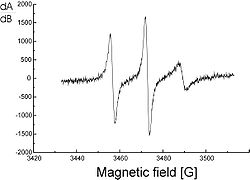
Site-directed spin labeling
Encyclopedia
Site-directed spin labeling (SDSL) is a technique for investigating protein
local dynamics using electron spin resonance. The theory of SDSL is based on the specific reaction of spin label
s with amino acid
s. A spin label's built-in protein structure can be detected by EPR spectroscopy. SDSL is also a useful tool in examinations of protein folding
process.
 Site-directed spin labeling (SDSL) was pioneered in the laboratory of Dr. W.L. Hubbell. In SDSL, sites for attachment of spin labels are introduced into recombinantly expressed proteins by site-directed mutagenesis
Site-directed spin labeling (SDSL) was pioneered in the laboratory of Dr. W.L. Hubbell. In SDSL, sites for attachment of spin labels are introduced into recombinantly expressed proteins by site-directed mutagenesis
. Functional group
s contained within the spin label determine their specificity. At neutral pH, protein thiol groups specifically react with the functional groups methanethiosulfonate, maleimide, and iodoacetamide, creating a covalent bond with the amino acid Cys
.
Spin labels are a unique molecular reporter, in that they are paramagnetic (contain an unpaired electron). Spin labels were first synthesized in the laboratory of H. M. McConnell in 1965. Since then, a variety of nitroxide spin label
s have enjoyed widespread use for the study of macromolecular structure and dynamics because of their stability and simple EPR signal.
The nitroxyl radical (N-O) is usually incorporated into a heterocyclic ring (e.g. pyrrolidine
), and the unpaired electron is predominantly localized to the N-O bond. Once incorporated into the protein, a spin label's motions are dictated by its local environment. Because spin labels are exquisitely sensitive to motion, this has profound effects on its EPR spectrum.
Dr. Ralf Langen's group showed that SDSL with EPR (University of Southern California, Los Angeles) can be used to understand the structure of amyloid fibrils and the structure of membrane bound Parkinson's disease protein alpha-synuclein.
Protein
Proteins are biochemical compounds consisting of one or more polypeptides typically folded into a globular or fibrous form, facilitating a biological function. A polypeptide is a single linear polymer chain of amino acids bonded together by peptide bonds between the carboxyl and amino groups of...
local dynamics using electron spin resonance. The theory of SDSL is based on the specific reaction of spin label
Spin label
A spin label is an organic molecule which possesses an unpaired electron, usually on a nitrogen atom, and the ability to bind to another molecule. Spin labels are normally used as tools for probing proteins or biological membrane-local dynamics using EPR spectroscopy. The site-directed spin...
s with amino acid
Amino acid
Amino acids are molecules containing an amine group, a carboxylic acid group and a side-chain that varies between different amino acids. The key elements of an amino acid are carbon, hydrogen, oxygen, and nitrogen...
s. A spin label's built-in protein structure can be detected by EPR spectroscopy. SDSL is also a useful tool in examinations of protein folding
Protein folding
Protein folding is the process by which a protein structure assumes its functional shape or conformation. It is the physical process by which a polypeptide folds into its characteristic and functional three-dimensional structure from random coil....
process.
Spin labeling

Site-directed mutagenesis
Site-directed mutagenesis, also called site-specific mutagenesis or oligonucleotide-directed mutagenesis, is a molecular biology technique in which a mutation is created at a defined site in a DNA molecule. In general, this form of mutagenesis requires that the wild type gene sequence be known...
. Functional group
Functional group
In organic chemistry, functional groups are specific groups of atoms within molecules that are responsible for the characteristic chemical reactions of those molecules. The same functional group will undergo the same or similar chemical reaction regardless of the size of the molecule it is a part of...
s contained within the spin label determine their specificity. At neutral pH, protein thiol groups specifically react with the functional groups methanethiosulfonate, maleimide, and iodoacetamide, creating a covalent bond with the amino acid Cys
Cysteine
Cysteine is an α-amino acid with the chemical formula HO2CCHCH2SH. It is a non-essential amino acid, which means that it is biosynthesized in humans. Its codons are UGU and UGC. The side chain on cysteine is thiol, which is polar and thus cysteine is usually classified as a hydrophilic amino acid...
.
Spin labels are a unique molecular reporter, in that they are paramagnetic (contain an unpaired electron). Spin labels were first synthesized in the laboratory of H. M. McConnell in 1965. Since then, a variety of nitroxide spin label
Spin label
A spin label is an organic molecule which possesses an unpaired electron, usually on a nitrogen atom, and the ability to bind to another molecule. Spin labels are normally used as tools for probing proteins or biological membrane-local dynamics using EPR spectroscopy. The site-directed spin...
s have enjoyed widespread use for the study of macromolecular structure and dynamics because of their stability and simple EPR signal.
The nitroxyl radical (N-O) is usually incorporated into a heterocyclic ring (e.g. pyrrolidine
Pyrrolidine
Pyrrolidine, also known as tetrahydropyrrole, is an organic compound with the molecular formula C4H9N. It is a cyclic secondary amine with a five-membered heterocycle containing four carbon atoms and one nitrogen atom...
), and the unpaired electron is predominantly localized to the N-O bond. Once incorporated into the protein, a spin label's motions are dictated by its local environment. Because spin labels are exquisitely sensitive to motion, this has profound effects on its EPR spectrum.
Dr. Ralf Langen's group showed that SDSL with EPR (University of Southern California, Los Angeles) can be used to understand the structure of amyloid fibrils and the structure of membrane bound Parkinson's disease protein alpha-synuclein.

